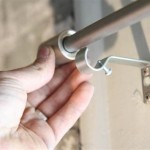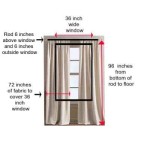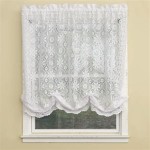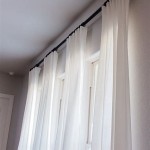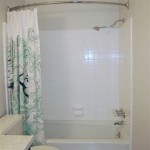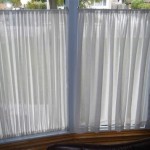How to Eliminate Curtain Belly: A Comprehensive Guide
Curtain belly, also known as curtain sag or curtain bulge, refers to the undesirable outward bowing of window curtains, creating a rounded, distended appearance. This phenomenon is a common problem that can diminish the aesthetic appeal of a room, making curtains look ill-fitting and detracting from the overall design. Several factors contribute to curtain belly, including improper installation, incorrect curtain dimensions, unsuitable fabric weight, and inadequate support mechanisms. Understanding these causes is crucial for implementing effective solutions to eliminate the problem.
Addressing curtain belly requires a multifaceted approach that considers both the initial installation and ongoing maintenance. This guide provides a thorough exploration of the causes of curtain belly and offers practical, actionable strategies to remedy the issue and prevent its recurrence, thereby ensuring that curtains hang elegantly and contribute positively to the room's decor.
Understanding the Root Causes of Curtain Belly
Identifying why curtain belly occurs is the first step towards rectifying the problem. Several factors can contribute to this common issue, and a careful assessment of the specific circumstances is essential for selecting the most effective course of action.
Incorrect Curtain Length: One of the most prevalent causes of curtain belly is using curtains that are either too long or too short for the window. Curtains that are excessively long tend to pool on the floor, creating an uneven distribution of fabric weight that results in bulging. Conversely, curtains that are too short can appear strained and may bow outwards due to insufficient material to hang properly.
The ideal curtain length is determined by the desired aesthetic. Options include:
- Floating: Curtains hang just above the floor, approximately half an inch to one inch above.
- Kissing: Curtains gently touch the floor.
- Puddled: Curtains extend several inches onto the floor, creating a dramatic, draped effect. This style is traditionally associated with more formal settings.
Choosing the appropriate length based on the intended style and carefully measuring the distance from the rod to the desired hemline is paramount to preventing curtain belly.
Insufficient Curtain Width: Inadequate width is another significant contributor to curtain belly. Curtains should be sufficiently wide to allow for proper fullness and draping when drawn. When curtains are too narrow for the window, they are stretched taut, which causes them to bow outwards in the middle because the fabric is attempting to cover a wider area than it is designed to.
As a general rule, the total width of the curtain panels should be at least two to three times the width of the window. This ensures that the curtains have enough fabric to create soft folds and pleats when closed, preventing the stretched, bulging appearance associated with insufficient width.
Improper Rod Support: The robustness of the curtain rod and its supporting hardware is crucial for preventing curtain belly. A flimsy or inadequately supported rod can sag under the weight of the curtains, particularly for heavier fabrics. This sagging effect not only compromises the overall appearance but also contributes directly to the outward bowing of the curtains.
The supporting brackets should be spaced appropriately based on the length of the rod and the weight of the curtains. For longer rods or heavier fabrics, additional brackets may be needed to provide adequate support and prevent sagging. It is essential to use high-quality brackets and ensure that they are securely mounted to the wall.
Fabric Weight and Texture: The weight and texture of the curtain fabric play a significant role in determining how the curtains hang. Heavy fabrics like velvet or brocade exert more downward force, which can exacerbate any existing issues related to length, width, or support. Lighter fabrics like linen or voile are less likely to contribute to sagging or bulging.
The texture of the fabric also influences its draping behavior. Fabrics with a looser weave may be more prone to stretching or deforming, while more tightly woven fabrics tend to hold their shape better. Consider the fabric characteristics when selecting curtains, particularly for larger windows or when using heavier materials.
Incorrect Header Design: The header of the curtain, which is the top portion that attaches to the rod, can significantly impact how the curtains hang. Different header styles, such as grommets, pleats, or rod pockets, distribute the weight of the fabric differently. Inadequate reinforcement or improper construction of the header can lead to sagging and contribute to curtain belly.
For heavier fabrics, consider using reinforced headers or selecting styles that provide more even weight distribution. Pleated headers, for example, can help to distribute the weight across multiple points, reducing the strain on any single area. Ensuring that the header is securely attached to the rod is crucial.
Practical Solutions for Correcting Curtain Belly
Once the underlying causes of curtain belly have been identified, implementing appropriate corrective measures can effectively eliminate the problem and restore the desired aesthetic. The following strategies offer practical solutions for addressing the various factors that contribute to curtain sag.
Adjusting Curtain Length: Addressing incorrect curtain length is a fundamental step in resolving curtain belly. If the curtains are too long, hemming them to the appropriate length will eliminate the excess fabric that contributes to the bulging. Conversely, if the curtains are too short, consider adding a decorative border at the bottom to increase their length or replacing them with curtains of the correct size.
When hemming curtains, ensure that the hem is even and that the stitching is secure. Professional tailoring services can provide precise and durable alterations. For adding length, choose a border fabric that complements the existing curtains and blends seamlessly with the overall design.
Increasing Curtain Width: If insufficient width is the culprit, the most effective solution is to add additional fabric to the curtains. This can be achieved by attaching side panels to the existing curtains or by purchasing new curtains with a wider total width. When adding side panels, select a fabric that matches or complements the existing curtains in terms of color, texture, and weight.
Alternatively, using multiple curtain panels can increase the overall width and create a fuller, more draped appearance. Ensure that the total width of all panels combined is at least two to three times the width of the window.
Reinforcing Rod Support: To address sagging caused by inadequate rod support, reinforce the existing hardware or replace it with more robust components. Adding additional supporting brackets, particularly in the center of the rod, can significantly increase its load-bearing capacity. Ensure that the brackets are securely mounted to the wall using appropriate anchors.
Consider using heavier-duty rods made from materials like steel or wrought iron, especially for heavier fabrics. These materials offer superior strength and resistance to bending or sagging. For very wide windows, using a continuous rod with multiple support brackets is often the best solution.
Managing Fabric Weight: Addressing issues related to fabric weight may require a more nuanced approach. For curtains made from excessively heavy fabrics, consider replacing them with lighter materials, such as linen or cotton. If replacing the curtains is not feasible, consider adding a lightweight lining to provide some structure and support without adding excessive weight.
Alternatively, consider using tiebacks or holdbacks to gather the curtains and distribute their weight more evenly. Tiebacks can be positioned strategically to prevent the curtains from bowing outwards. For heavy curtains, consider using reinforced tiebacks that can withstand the weight of the fabric without sagging.
Adjusting the Header: To address header issues, consider reinforcing the header with additional stitching or adding a stiffening agent to provide more structure. For rod pocket headers, ensure that the pocket is wide enough to accommodate the rod without causing the fabric to bunch or sag. For pleated headers, ensure that the pleats are evenly spaced and securely stitched.
For grommet headers, ensure that the grommets are securely attached to the fabric and that the fabric is reinforced around the grommets to prevent tearing or stretching. Consider using larger grommets for heavier fabrics to distribute the weight more evenly. Switching to a different header style might resolve the issue if the old style does not properly support the curtain.
Preventative Measures for Maintaining Optimal Curtain Appearance
Beyond correcting existing instances of curtain belly, implementing preventative measures is crucial for maintaining the aesthetic appeal of curtains over the long term. Proactive steps can minimize the likelihood of future sagging and ensure that curtains continue to enhance the room's decor.
Regular Cleaning and Maintenance: Dust and dirt accumulation can weigh down curtains, contributing to sagging and bulging. Regular cleaning, either by vacuuming or washing according to the fabric's care instructions, helps to maintain the fabric's integrity and prevent the accumulation of debris. Periodic laundering is also crucial for some fabrics to maintain the shape and structure of the curtains.
Ensure that curtains are properly dried after washing to prevent shrinkage or distortion. Ironing or steaming can help to remove wrinkles and restore the fabric's original appearance.
Proper Storage: When curtains are not in use, such as during seasonal changes, proper storage is essential to prevent damage and maintain their shape. Fold the curtains neatly and store them in a cool, dry place away from direct sunlight. Avoid storing curtains in damp or humid environments, as this can lead to mildew and discoloration.
Use acid-free tissue paper to protect delicate fabrics and prevent creasing. Consider storing curtains in garment bags to protect them from dust and pests.
Periodic Inspections: Regularly inspect curtain hardware, including rods, brackets, and hooks, to ensure that they are in good condition. Tighten any loose screws or bolts and replace any damaged or worn-out components. Inspect the curtains themselves for signs of wear and tear, such as loose seams or frayed edges. Address any minor issues promptly to prevent them from escalating into more significant problems.
Pay particular attention to the header and hem, as these areas are most susceptible to damage. Reinforce any weak spots before they lead to sagging or tearing.
By implementing these preventative measures, individuals can significantly reduce the risk of curtain belly and ensure that their curtains continue to hang elegantly and contribute positively to the room's overall aesthetic. A proactive approach to curtain care is essential for maintaining their beauty and prolonging their lifespan.

How To Get Rid Of Apron Belly With Diet And Exercise

What Is Fat Apron Belly Panniculectomy By Dr Repta

What Is An Apron Belly Causes Solutions

How To Get Rid Of Apron Belly With Diet And Exercise

What Is An Apron Belly Causes Solutions

How To Get Rid Of Apron Belly With Diet And Exercise

How To Get Rid Of Apron Belly With Diet And Exercise

What Is An Apron Belly How Can You Get Rid Of It Karidis Clinic

Get Rid Of An Apron Belly To Do This 10 Min Workout

How To Get Rid Of Apron Belly With Diet And Exercise

